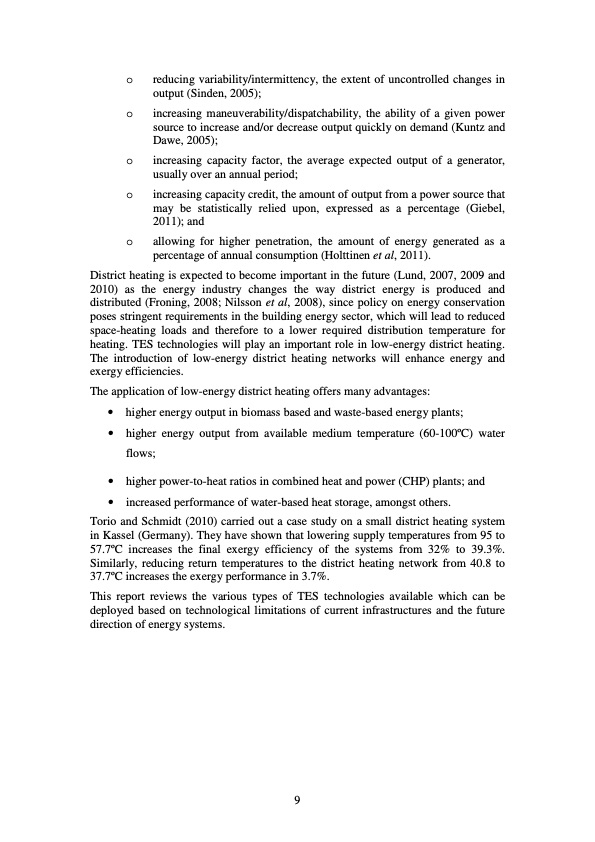
PDF Publication Title:
Text from PDF Page: 009
o reducing variability/intermittency, the extent of uncontrolled changes in output (Sinden, 2005); o increasing maneuverability/dispatchability, the ability of a given power source to increase and/or decrease output quickly on demand (Kuntz and Dawe, 2005); o increasing capacity factor, the average expected output of a generator, usually over an annual period; o increasing capacity credit, the amount of output from a power source that may be statistically relied upon, expressed as a percentage (Giebel, 2011); and o allowing for higher penetration, the amount of energy generated as a percentage of annual consumption (Holttinen et al, 2011). District heating is expected to become important in the future (Lund, 2007, 2009 and 2010) as the energy industry changes the way district energy is produced and distributed (Froning, 2008; Nilsson et al, 2008), since policy on energy conservation poses stringent requirements in the building energy sector, which will lead to reduced space-heating loads and therefore to a lower required distribution temperature for heating. TES technologies will play an important role in low-energy district heating. The introduction of low-energy district heating networks will enhance energy and exergy efficiencies. The application of low-energy district heating offers many advantages: • higher energy output in biomass based and waste-based energy plants; • higher energy output from available medium temperature (60-100oC) water flows; • higher power-to-heat ratios in combined heat and power (CHP) plants; and • increased performance of water-based heat storage, amongst others. Torio and Schmidt (2010) carried out a case study on a small district heating system in Kassel (Germany). They have shown that lowering supply temperatures from 95 to 57.7oC increases the final exergy efficiency of the systems from 32% to 39.3%. Similarly, reducing return temperatures to the district heating network from 40.8 to 37.7oC increases the exergy performance in 3.7%. This report reviews the various types of TES technologies available which can be deployed based on technological limitations of current infrastructures and the future direction of energy systems. 9PDF Image | EPSRC Thermal Management of Industrial Processes

PDF Search Title:
EPSRC Thermal Management of Industrial ProcessesOriginal File Name Searched:
Sheffield__EPSRC_progress_report_Thermal_storage_July2011.pdfDIY PDF Search: Google It | Yahoo | Bing
NFT (Non Fungible Token): Buy our tech, design, development or system NFT and become part of our tech NFT network... More Info
IT XR Project Redstone NFT Available for Sale: NFT for high tech turbine design with one part 3D printed counter-rotating energy turbine. Be part of the future with this NFT. Can be bought and sold but only one design NFT exists. Royalties go to the developer (Infinity) to keep enhancing design and applications... More Info
Infinity Turbine IT XR Project Redstone Design: NFT for sale... NFT for high tech turbine design with one part 3D printed counter-rotating energy turbine. Includes all rights to this turbine design, including license for Fluid Handling Block I and II for the turbine assembly and housing. The NFT includes the blueprints (cad/cam), revenue streams, and all future development of the IT XR Project Redstone... More Info
Infinity Turbine ROT Radial Outflow Turbine 24 Design and Worldwide Rights: NFT for sale... NFT for the ROT 24 energy turbine. Be part of the future with this NFT. This design can be bought and sold but only one design NFT exists. You may manufacture the unit, or get the revenues from its sale from Infinity Turbine. Royalties go to the developer (Infinity) to keep enhancing design and applications... More Info
Infinity Supercritical CO2 10 Liter Extractor Design and Worldwide Rights: The Infinity Supercritical 10L CO2 extractor is for botanical oil extraction, which is rich in terpenes and can produce shelf ready full spectrum oil. With over 5 years of development, this industry leader mature extractor machine has been sold since 2015 and is part of many profitable businesses. The process can also be used for electrowinning, e-waste recycling, and lithium battery recycling, gold mining electronic wastes, precious metals. CO2 can also be used in a reverse fuel cell with nafion to make a gas-to-liquids fuel, such as methanol, ethanol and butanol or ethylene. Supercritical CO2 has also been used for treating nafion to make it more effective catalyst. This NFT is for the purchase of worldwide rights which includes the design. More Info
NFT (Non Fungible Token): Buy our tech, design, development or system NFT and become part of our tech NFT network... More Info
Infinity Turbine Products: Special for this month, any plans are $10,000 for complete Cad/Cam blueprints. License is for one build. Try before you buy a production license. May pay by Bitcoin or other Crypto. Products Page... More Info
| CONTACT TEL: 608-238-6001 Email: greg@infinityturbine.com | RSS | AMP |